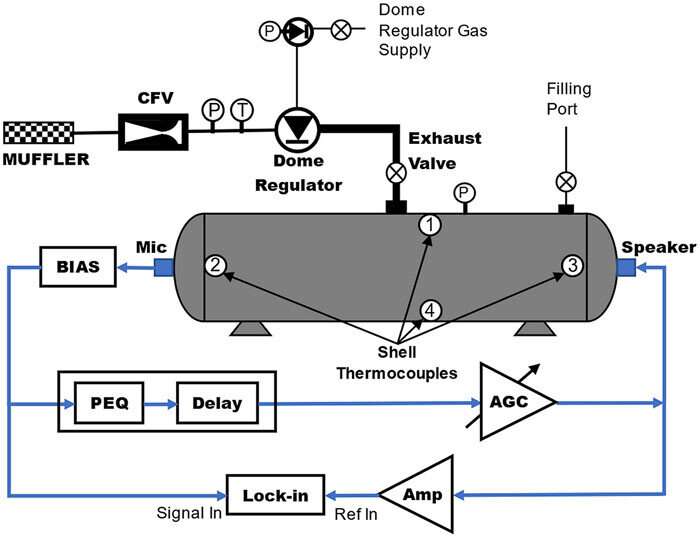Schematic circuit to achieve self-oscillation of acoustic waves in a pressure vessel using positive feedback. The circuit includes a microphone (Mic), a speaker, an amplifier (Amp), an automatic gain control (AGC), a bandpass filter (parametric equalizer, PEQ), a phase adjustment (Delay), and a lock-in amplifier (Lock-in). We used the same circuit for both vessels used in this work. During operation, gas flows from the vessel through the dome pressure regulator and through a critical flow venturi (CFV) acting as a meter under test (MUT). Credit: Review of Scientific Instruments (2023). DOI: 10.1063/5.0143819
Researchers at NIST have developed a new—and sound—way to accurately measure the rate at which gas flows in and out of a vessel. The technique, which uses acoustic waves to determine the average temperature of the gas and microwaves to ascertain the volume of the vessel, can measure gas flows and leaks from large containers particularly well.
The method could enable workers to more accurately calibrate gas flow meters used in natural gas pipelines. The monetary value of natural gas in U.S. pipelines exceeded $90 billion in 2016, so the accuracy of these measurements is a key concern for both consumers and providers of natural gas.
"We believe that the acoustic technique, once perfected, could be adopted as a new standard at NIST, and potentially around the world," said NIST researcher Jodie Pope.
To determine the amount of gas flowing out of a vessel, researchers need to know several quantities, including the volume of the vessel and the pressure and temperature of the gas.
In the current method of measuring gas flow, developed at NIST and now the national standard for calibrating flow meters, workers determine the temperature of the gas by submerging the vessel in a temperature-controlled water bath. Because the technique allows enough time for the temperature of the gas to come to equilibrium with the temperature of the water bath, the gas temperature can be determined with high accuracy.
However, measuring the temperature of gas flowing from large vessels poses a problem because the containers can't easily be submerged in a water bath. An alternative—relying on numerous temperature sensors placed inside the vessel—can be impractical due to the sheer number of sensors, each of which would require a separate calibration.
To calibrate large gas flows using the current national standard, metrologists must use a bootstrap strategy: They calibrate multiple flow meters that measure relatively small flows and pressures, then mount the meters in parallel to achieve bigger flows and pressures in multiple steps that require up to 48 calibrations. This procedure adds both cost and uncertainty to the measurements.
Credit: National Institute of Standards and Technology
The new method employs acoustic waves to determine the average gas temperature in large vessels. This technique, which does not require extra temperature sensors, is reliable even if the temperature varies across the volume of the gas, said Pope. Because of these advantages, the technique could significantly decrease the number of steps in the calibration chain and thereby reduce the uncertainty in the final flow measurement.
To demonstrate the new technique, the NIST team mounted a source of sound waves (a speaker) at one end of a cylindrical vessel and a microphone at the opposite end of the system. The microphone receives the sound waves, which are modified and then fed back into the system to reinforce and strengthen the source waves.
This arrangement, known as a positive feedback loop, creates a self-sustained acoustic oscillation at the natural, or resonance, frequency of the gas, much the way an organ pipe reverberates at particular set of frequencies. The resonance frequency depends on the speed of sound in the gas, which in turn is proportional to the average temperature of the gas. By tracking the resonance frequency, the sound waves measure the average temperature of the gas—without the need for a water bath or a large number of temperature sensors.
Even if the temperature of the gas in the vessel changes, which it will when gas flows in or out of the container, the acoustic system's ability to lock onto the resonance frequency guarantees that the instantaneous temperature of the gas is always known. For instance, when gas exits a vessel, the temperature of the remaining gas decreases. But because the resonant frequency of the gas decreases in sync with the decreasing temperature, the system is able to record the lower temperature.
The researchers combined their precision temperature measurements with measurements of the volume of gas, using microwaves, and the gas pressure, to determine the flow rate.
One advantage of the acoustic technique is that it's relatively simple, said NIST researcher Keith Gillis. "There are no moving parts; the only thing that is moving is the gas."
Before the acoustic method can become a standard, researchers will have to test the technique with larger vessels and gas flows.
The study is published in the journal Review of Scientific Instruments.
More information: Jodie G. Pope et al, Dynamic measurement of gas flow using acoustic resonance tracking, Review of Scientific Instruments (2023). DOI: 10.1063/5.0143819
Journal information: Review of Scientific Instruments
Provided by National Institute of Standards and Technology
This story is republished courtesy of NIST. Read the original story here.
























